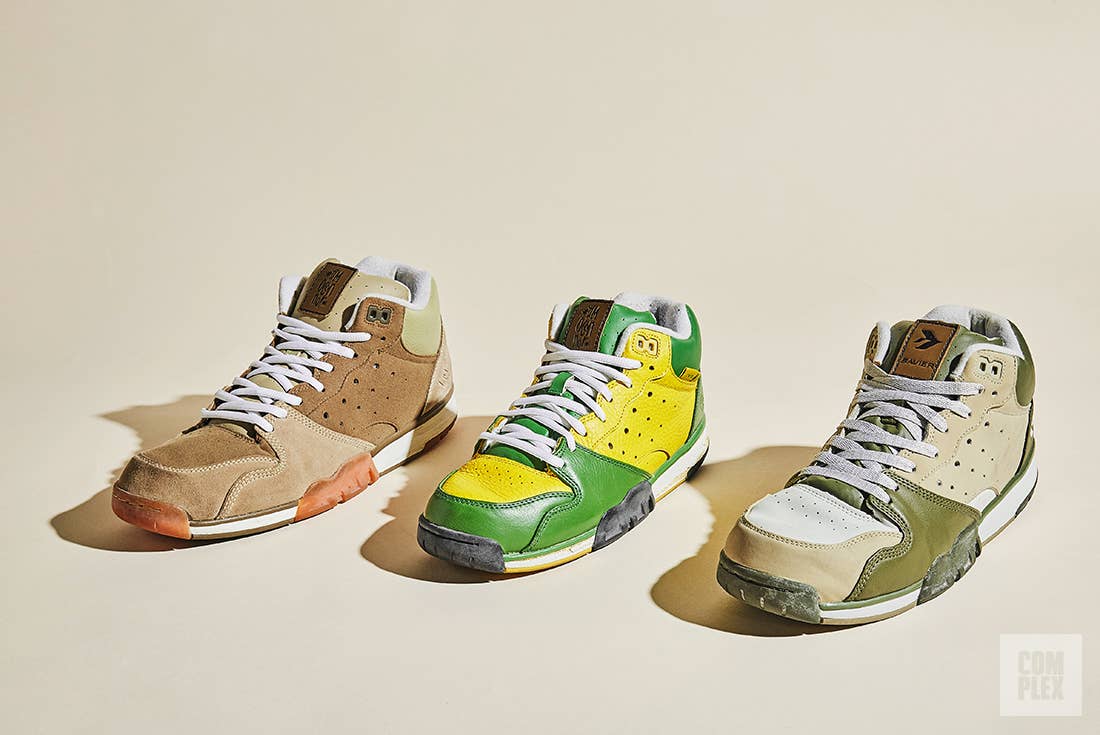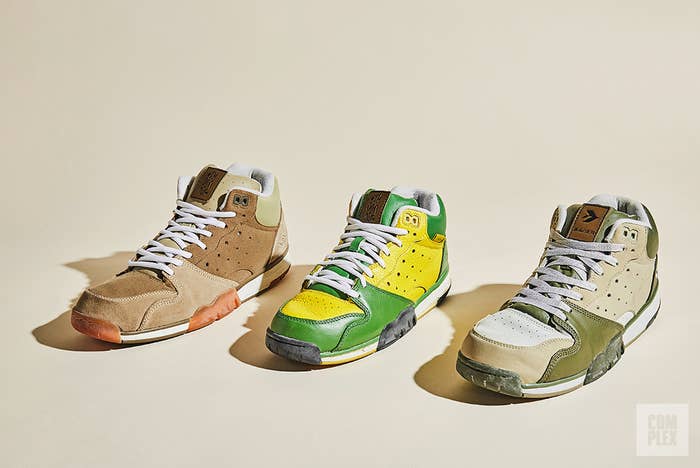
When Nike quietly purchased the Portland, Oregon-based skateboarding sneaker start-up Savier in 2001, the entire sneaker industry was wading in a massive sea of change that few predicted. Launched independently in the fall of 2000, Savier's role in skateboarding footwear's canon is a story about design and marketing, and even folklore, that’s steeped in the hazy salad days of digital media. Remembered by many as a calculated plan for Nike to stealthily infiltrate skateboarding, the reality is much more organic and innocent, even if Savier's short run birthed, or at least shaped, the blueprint of Nike's SB program.
To this day, Savier is viewed by many as SB's beta-test. Former Savier marketing manager and co-founder and CEO of YORK Athletics Mark McGarry downplays the assertion. "I know this to be true is Paul Fidrych—the president of Savier—was brought out to Nike and he presented [Nike co-founder] Phil Knight with the idea for the brand," he says. "He explained that if Nike wanted to successfully break into the skate industry, they should do it through a separate brand and not a sub brand. That’s how the relationship really came to be."
With the rise of blogging and digital media in general, the gap between consumer and manufacturer was closing in the early 2000s, leading to product that echoed what a burgeoning culture wanted stylistically in footwear more than just tech. Prior to the birth of the "drop," release dates were foggy, with diehards hounding brick-and-mortar employees about when a new Jordan would be stocked rather than lining up hours in advance only to flip product on reseller sites. Through collaborations and a general buzz due to their connection to Nike, Savier was pioneering in creating product that spoke to the shift, despite their brief existence.
Skateboarding specifically has always had a unique place in the shoe equation, as skate shoes have historically been the intersection of performance and look. As Vans and Vision Street Wear crossed over in the '90s, core skate brands began to crossover into the mainstream, partially due to a boost by the Beastie Boys, who championed both deadstock classics and newer models fueled by their aesthetic. In many ways it was the birth of retro-culture, but it soon gave way to tech, with many brands, including Vans—known for their clean vulcanized look-- skate shoe design by adding layers of plastic, cord lacing, and sometimes faux-airbags. On the tech side, it was DC Shoe Co. and éS offering the most advanced models, often inspired by insights culled from riders and team members who were drawing from popular basketball and soccer shoes.
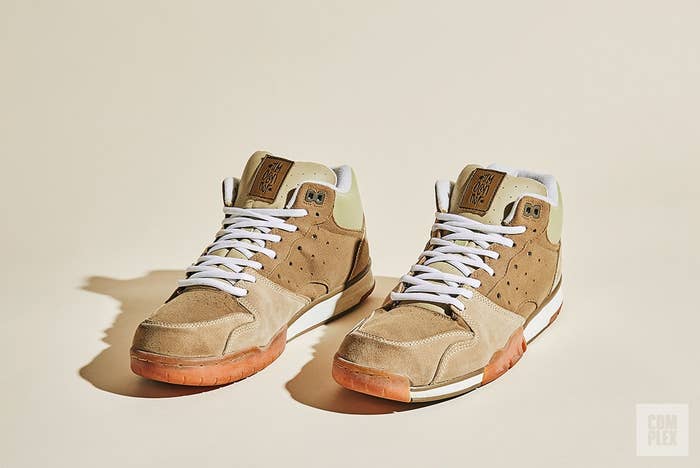
During this period, skateboarding's public reemergence due to ESPN's X-Games drew outside companies including Nike, Adidas, Converse, and Puma into the shoe game to little relevance. Even with the authenticity of respected skaters' input, all of the programs failed to resonate or penetrate the market. While it’s a valid debate that the culture’s adversity to corporate influence was a natural pushback, even Converse, whose designs were the most fueled by pros and industry vets, still appeared clunky and misguided, even if they actually performed.
"Initially they told me Jon Humphries was doing the photography and concepts for the ads, and I could already see that Jon was killing it," says former Savier pro Tim O'Connor. "It was obvious that Jon had a unique vision for the ads, and he was another reason that it was a no-brainer to ride for them. The Nike connection was funny, because that was really played down. They clearly didn't want it to be known that Nike was affiliated with Savier in the beginning. Nike tried to break into skating before and their skate specific shoes and skate programs were terrible. No one in skating that had a good offer somewhere else would've wanted to ride for Nike at that point.
O'Connor goes on to say, "I think the whole Vita [A tech-forward shoe brand started by Mark Oblow and Natas Kaupas] team was offered to ride for Nike when Vita was done, but all of us, except for Reese Forbes, turned that down because of less than stellar results Nike had produced with skateboarding in prior years. The only thing I remember being told was that Savier had a deal of some sort with Nike and that they had access to Nike technologies to use on their shoes. At some point Savier did a complete 180, and they were more than happy to highlight their affiliation with Nike. I always said that Nike had amazing skate shoes already, and they didn't even know it.”
In a sense, skateboarding footwear's "tech boom" was owned by core companies. But skateboarding has never been tech driven. Yes, innovations such as urethane wheels, concaves, truck innovations, and board shapes propelled functionality and spurred progression, but a skateboard from 1999 is almost identical to one in 2019. And if you look at the popularity of Vans and Converse staple models, specifically the Chuck Taylor, it’s easy to see that look often usurps functionality.
With Nike as a somewhat silent partner, Savier was a unique entrant to the market, as they had the appearance of a core brand with the benefits of an industry giant, specifically Nike’s proprietary technology and vast resources. With an initial team of Brad Staba and Brian Anderson, later adding Tim O’Connor, Stefan Janoski, and John Rattray, they had the roster and the mission to make “the best skate shoes possible.” The brand’s hivemind was comprised of former Burton Snowboards employee Paul Fidrych, who worked closely with the brand’s riders to develop product and made that synergy the DNA of Savier. Along with Fidrych were close friends and colleagues Jeff Jewett and Rob LaVigne. Jewett had experience directing a skatepark, and LaVigne was steeped in action sports experience, including his time running Adidas' skate program in the '90s. What the trio may have lacked was foresight to some degree, but how they nimbly reacted to Savier’s reception was forward thinking and predictive of product development and overall marketing strategy.

Depending on who you ask now, Savier's initial product offering was either sleek or garish, making them an enigma, but the quality was noticeably elevated to all. They offered a seamless Interfuse tech to their shoe designs to avoid ripping and wear and the rubber and plastic additions to their lasts were more than adornments, each providing actual benefits as well as contributing to their unique look. Most importantly, the shoes themselves—often seeded to skatepark dwellers by the team themselves—provided true comfort and durability.
"Steve McDonald [co-founder of Nike’s ACG line] was one of the main designers," says former Savier art director Eric Peet. "What was interesting about the first shoes was that he was really trying to like solve a lot of durability problems, but it didn't catch on, which is interesting now because I just bought my son a pair of Nyjah Huston’s Nike SBs and they literally don't fall apart. [The design team] always focused on putting these, like, little innovations in there. Paul was a product nerd. He invented this inner technology that would grab your sock so it wouldn't slip down—just small tweaks with big fit benefits."
Despite initial sales being slow, Savier's personality and presentation engendered the brand to skateboarders. Along with their footwear offerings, they were producing high-end apparel and accessories, offering a full breadth of product and vision. With everything being max tech, their creative direction was loose, artistic, and often irreverent with the best example being the branded bottle opener that came attached to each pair's lace holes, an idea loosely attributed to original team rider Brad Staba. It was a nod to skateboarding’s "fuck you spirit," and counter to how heavily engineered each piece was.
"They let us do whatever ridiculous shit we wanted and I loved how they let us be the artsy dorks that we were," says O'Connor. "Brian Anderson, Stefan [Janoski], Brad [Staba], and myself were all really into art in some form or another. They let us do the giant murals as an ad series which was incredibly original. They let me do fake descriptions of the features on my pro model shoe that were complete insanity. They used my sketchbooks for artwork to put on my pro model shoe box. They let our personalities shine through. Like most skaters, I don't really know shit about shoe design. I know if I like a shoe or if I don't like a shoe. I was hands on in choosing a minor feature here and there but in all reality it was left up to the designer."
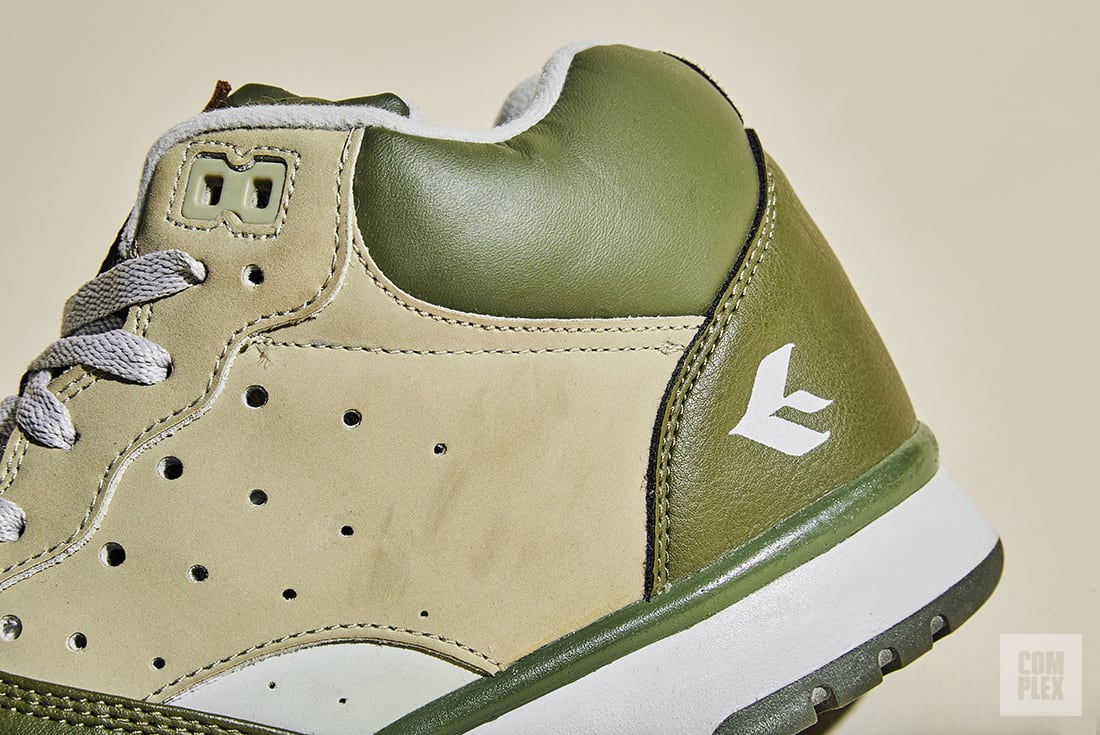
Peet and McGarry both joined the brand after they had been in operation for roughly two years, adding a new creative spark and enthusiasm, albeit unintentionally as McGarry told me. "I remember, like, the first month in or something, there was an ASR trade show and Paul told me to get media kits ready for it. I'm like, 'What the fuck is a media kit?' I walked back to Eric and asked what a media kit was and he just starts laughing—I'm the guy that's supposed to be in charge of this! It was just this crash course for me and like entrepreneurship and like rolling up your sleeves and getting shit done."
"In the beginning the shoes were too bulky and I tended to gravitate more towards shoes like Staba's pro model," says O'Connor. "His shoe was tech but the tech was streamlined and I don't recall it being bulky by any means. I couldn't skate [Brian Anderson's] shoe because it was just way too bulky and impenetrable for me. Honestly there was some amazing technology being used in some of those shoes, but I definitely remember thinking some were crazy looking even for then. I chose solid colors that hid the busy features if I was riding one of the crazier looking shoes.”
Skate footwear's aforementioned "tech-boom," coincided with skating itself reaching what was then a technical apex. Everything was getting as big, difficult, and complex but without the clunky "flip-and-pray," often snail-paced skating of the early-'90s. In a sense, skateboarding's mainstream attention on the contest level had brought a uniformity and almost athletic aesthetic to everything from board graphics and clothing—a push back was eminent. A shot to the swishy pants and basketball jerseys of the early-2000s, everything from the Baker Crew's Johnny Thunders-inspired ‘70s punk look to the irie dreadlocked brown corduroy tropes associated with iPath and Rasa Libre began to symbolize a shift and polarization. Along with stylistic changes and actual onboard differentiation, the puffy shoes that Nike SB team rider Stefan Janoski, once referred to as "baked potatoes," were giving way to slimmer models that looked more streamlined with tighter clothing. Internally, Peet was pivotal in pushing back on Savier's design tenets, arguing that advancement didn’t need to be so outward and that the brand could provide innovative and durable shoes without them looking futuristic. With plenty of Savier product still on the racks, Peet's instincts and fervor resulted in dramatic changes in the line, specifically two of O'Connor's models.
"I have no idea if I gave input into slimming the shoes down but you could see that the trend was going towards a more basic design," says O'Connor. The "Story" model was specifically emblematic, resembling an iconic Adidas tennis shoe.
"It is completely crazy to think that it was totally a Rod Laver being done by a Nike-affiliated company. It was the designer's idea [to have handwritten text on the entire sole], I just supplied the words that were used for the tread on the sole," says O'Connor. "It was an amazing idea and I wish I could say it was all mine. I also wish I could remember the shoe designer’s name, because he was awesome. He's probably still killing it wherever he's at. I really loved the way that shoe looked but I actually didn't skate them a lot because they didn't feel like they had enough padding for me back then. Janoski skated them all the time and he loved that slim low-profile type of shoe. Stefan liking that type of shoe is what led to him ultimately creating a Nike sneaker that was all the things he liked which worked out lovely for him—couldn't have happened to a better human."
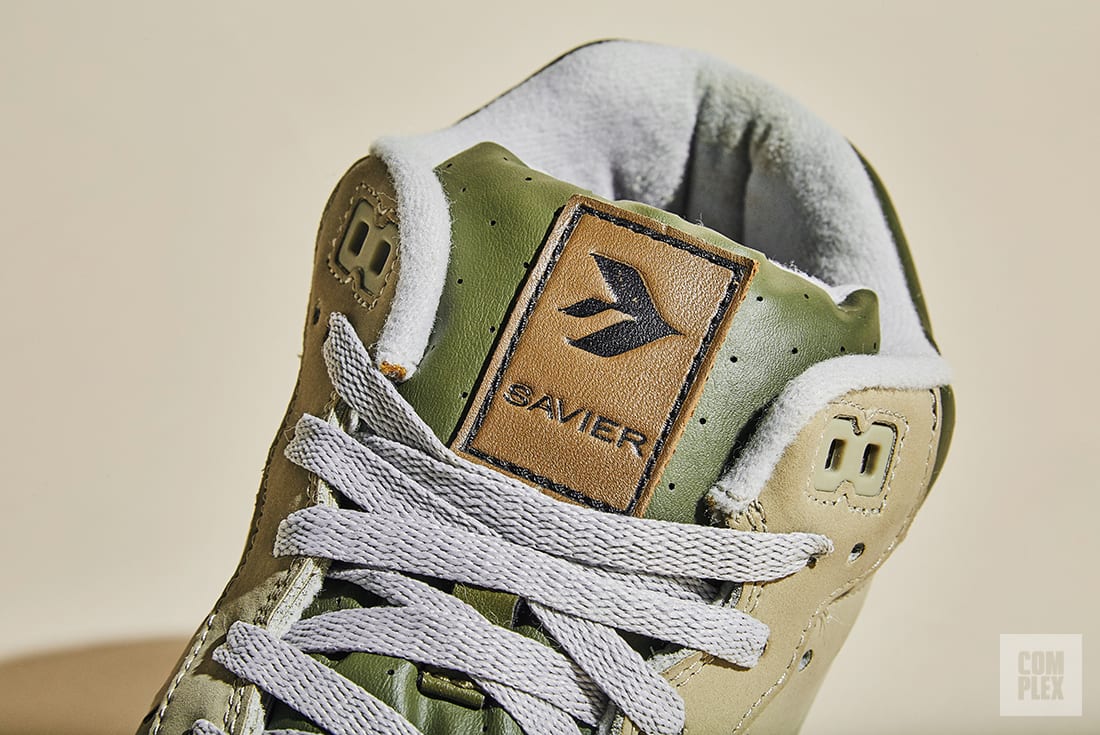
Though the Story was closer to the bullseye of where skate shoes were trending, the inherent lack of grip and padding prevented it from becoming a mainstay. Later models including the Fulton and O'Connor's Trainer model were not only popular for their aesthetics, but gave the brand a vehicle to collaborate with Joe Castrucci and Habitat Skateboards as well as the influential sneaker blog Fixins. Most importantly, the Trainer and its lines derived specifically from the Nike Air Trainer 1 model, which might have offered the future Nike SB program a spark and direction.
"One of the designers presented that idea to me and I was immediately on board," O'Connor says. "I loved mid-tops and still do. I think I quit Savier right as those came out, but I really liked that one. I remember doing a demo for Habitat after I quit Savier and I was skating in some Nike Dunks at the demo while the shop had just gotten my Savier shoe. I felt bad that the shop had just received their order and I wasn't even skating the shoe that the owner thought the kids would see me in."
"When we launched that model Complex immediately did a feature on it, then Hypebeast and Fixins followed up—it was getting some traction," says McGarry. "We had access to all the Nike lasts and using them created all this excitement—there was that crossover with sneakerhead culture mixing with skateboarding. My learning was that Nike realized it made more sense to do a skate shoe with a Swoosh rather than not based on the success of Tim's model. That birthed the Dunk SB strategy in my opinion. They saw the resonance of simpler designs and the desire for classic sneakers."
O'Connor, Peet, and McGarry all agree that Savier’s demise was predicated on several factors, including lack of sales and expansion into action sports outside of skateboarding, as well as the bizarre addition of Shawn White. Internally there was skepticism that Savier was to become a broader program, based in skateboarding but much more akin to Nike's now defunct 6.0 program. The also both agreed that it was Sandy Bodecker's passionate drive to bring an authentic, impactful skateboarding program to Nike's proper umbrella. By 2004, Savier was dissolved in a mutual agreement between Nike and the independent start-up.
"They obviously burned through a shit ton of money in a short amount of time," O'Connor says. "They probably went too big too fast with all the products they were producing and the sales just weren't there. They made a ton of amazing, high-quality bags. but I can't imagine they sold a ton of those. They would've been a great backpack company in of itself. Mistakes were made like you have at any company that goes out of business. Dan Wolfe came with us on a trip or two and we did some online tour videos. But internet speeds were absolutely pathetic back then I can't imagine that was much of a success since it would take 12 hours to download a five minute video over dial-up. They were too ahead of their time with that move and should've just put out some tour DVDs. There was probably a lot of money wasted on their website come to think of it. They knew where things were going but they were there before people were ready for it and burned a lot of calories and money on that aspect.”
"It was more like connecting them [Nike} with some important people that might've been hard for them to do," Peet says of Savier’s demise and SB’s birth. "When Sandy got to do Nike SB, it was a clean break. I think it's just things just change and ebb and flow. Savier was right in the middle trying to do both. They were trying to be tech when things were moving away from it. The most interesting thing is the former Savier office is now the Nike SB skate park here in Portland, Oregon."

